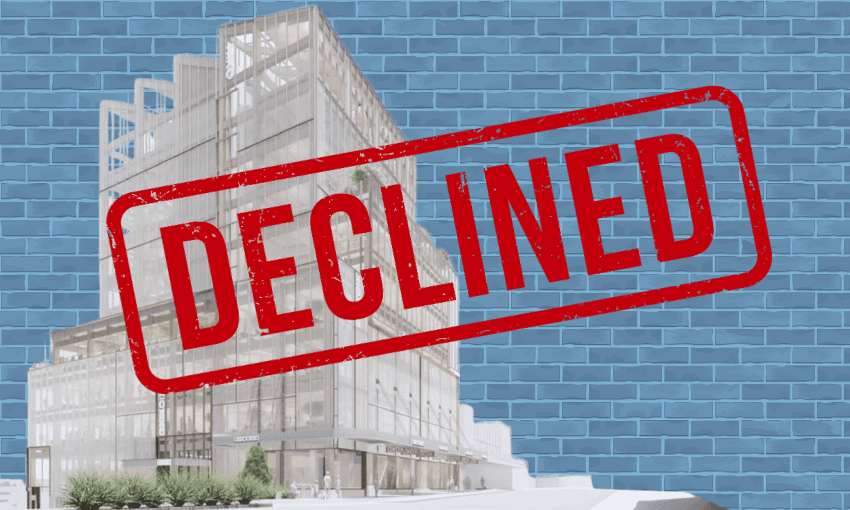Lots of councils find reasons to stop construction. Few do it with as much panache as Auckland.
When the developer James Kirkpatrick Group ordered a design for an 11-storey building on Karangahape Road, it probably believed resource consent would be a formality. The commercial building, with offices up top and shops on street level, was set to be built on an empty gravel site close to the new Karanga-a-Hape train station. Councils have been ordered by the government to allow tall buildings near train stations in part so more people can use the rail network we’ve just spent $5.5 billion upgrading. Besides that, the building would sit squarely in the city centre zone, where authorities are supposed to allow as much construction as possible.
If the developer was thinking that way, it didn’t bargain on the Picasso-esque creativity of Auckland Council when it comes to stopping construction. Last month commissioners denied resource consent for the new building, citing its “more than minor” effects on the environment.
To arrive at that conclusion, they relied on submissions from council’s planners and the Waitematā local board, both of which raised concerns the development would “dominate” the streetfront. So true. Why would you want new retail or restaurants dominating the streetfront when you could enjoy the urban feng shui of some gravel with a fence in front of it instead?
The Da Vincis of denial weren’t done. They said the new building would compromise the heritage of the local area. When confronted with the reality of the site currently being an empty lot whose immediate neighbours are a carpark and a Mobil station, the council’s urban design expert Chris Butler argued the “real world” context of the development extends down Karangahape Road and through the southern end of Ponsonby Road. Why only that far? Surely the real world setting of this building is all of New Zealand itself, which broke off from the supercontinent Pangaea, which in turn was formed out of the dust flung across the galaxy by the Big Bang, and if you think about it that way, nothing should ever be built anywhere ever.
In a final splash of colour, a submission on behalf of the local board from the allegedly Green-aligned member Alexandra Bonham raised concerns about a lack of carparking in the building, which, again, is situated on a new cycleway a five-minute walk from a new train station.
James Kirkpatrick Group, after blinking slowly several times, decided to appeal the decision. Infrastructure and RMA reform minister Chris Bishop also seemed flabbergasted, calling the denial “insanity”.
If they’d looked at recent history, they’d have been less shocked. Auckland Council has been issuing bizarre consent denials with a prodigiousness and creative flair matched only by early-career Mozart. Over in Balmoral, its planners found an unregistered architect to help them stop three townhouses being built on the site of a derelict dairy described as a “pile of shit” by its neighbours. The council argued the townhouses would compromise the historic aura of the “Balmoral tram suburb” – a claim undermined by the fact there was never a tram in the area.
Council eventually lost that fight. But you miss 100% of the shots you don’t take. In Waiuku it had more luck, putting onerous conditions on a proposed dairy because it was worried people stopping for coke lollies would cause traffic snarl-ups in the town an hour south of Auckland centre. Though the council may love crumbling, rotten dairies, it sure doesn’t like new ones.
Somehow these aren’t even the most tenuous reasons the council has come up with for banning construction in recent memory. Faced with the prospect of people building apartments near a train station and other amenities in Sylvia Park, its planning team searched the recesses of their collective brains and came up to the ingenious conclusion that tall buildings would ruin motorway drivers’ spiritual connection to the vision of a small hill. Nice try developers, but it’ll take more than an overwhelming weight of evidence to force this team to consent to housing.
Though ensuring drivers are able to crash into a median barrier after being overawed by the sight of a hillock is important, most of the time the council simply denies housing on “character” grounds. Because character is a nebulous term which basically amounts to “rich people live here”, it’s still able to express house-halting creativity within those bounds. Memorably, the council faced off against its own urban development agency Eke Pānuku in court over plans to build apartments and shops on Dominion Road, which it argued wasn’t worth the demolition of a single modified, post-war building that wasn’t so much character as “character supporting”.
Through all of this, central government politicians of all stripes have impressed the importance of new construction. New Zealand, they argue, has a debilitating housing crisis caused in large part by councils not issuing enough resource consents for roughly 50 years straight. Furthermore, the nation is currently a bit skint, and needs the economic activity generated by new residential and retail buildings. Auckland Council simply does not care. It cannot be stopped. The maestros won’t stop saying no until their symphony is finally complete and the city resounds in a great synchronised chorus of “consent application denied”. Only one thing could stop their creative flow: turning around and denying them the consent to keep denying consents.
Following the decision to stop James Kirkpatrick Group’s Karangahape Road, Bishop noted the government’s ongoing efforts to reform the Resource Management Act. It was insanity like this, he said, that was motivating the government to push on. Though the consent denials still come thick and fast, our council might soon be forced to issue a frightening, under-utilised word: yes.


